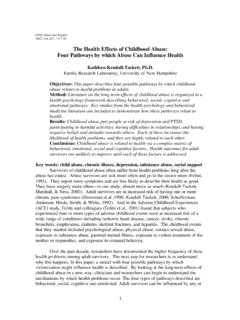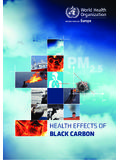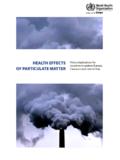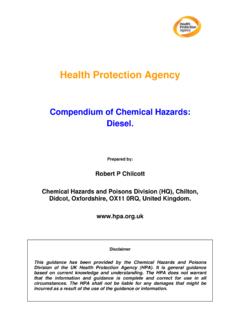Transcription of Effectsofcaffeineonhumanhealth - Community …
1 Food Additives and Contaminants, 2003, Vol. 20, No. 1, 1 30. E ects of ca eine on human health P. Nawrot*, S. Jordan, J. Eastwood, J. Rotstein, A. tal malformations, development, fertility, foetal Hugenholtz and M. Feeley growth, pregnancy, spontaneous abortion, tea Toxicological Evaluation Section, Chemical health Hazard Assess- ment Division, Bureau of Chemical Safety, Food Directorate, health Canada, Tunney's Pasture, PL 2204D1, Ottawa, Ontario, Canada K1A 0L2 Introduction (Received 19 November 2001; revised 17 June 2002; accepted Ca eine (1,3,7-trimethylxanthine) is a natural alka- 18 June 2002). loid found in co ee beans, tea leaves, cocoa beans, cola nuts and other plants. It is probably the most Ca eine is probably the most frequently ingested frequently ingested pharmacologically active sub- pharmacologically active substance in the world.
2 It is stance in the world, found in common beverages found in common beverages (co ee, tea, soft drinks), in (co ee, tea, soft drinks), products containing cocoa products containing cocoa or chocolate, and in medica- or chocolate, and medications, including headache or tions. Because of its wide consumption at di erent pain remedies and over-the-counter stimulants levels by most segments of the population, the public (Murphy and Benjamin 1981, IARC 1991b, Dlugosz and the scienti c Community have expressed interest in and Bracken 1992, Carrillo and Benitez 1996). the potential for ca eine to produce adverse e ects on human health . The possibility that ca eine ingestion The possibility that ca eine consumption can have adversely a ects human health was investigated based adverse e ects on human health was assessed based on reviews of (primarily) published human studies on the results of (primarily) published human studies obtained through a comprehensive literature search.
3 Obtained through a comprehensive literature search. Based on the data reviewed, it is concluded that for The results of this assessment are summarized here. the healthy adult population, moderate daily ca eine intake at a dose level up to 400 mg day 1 (equivalent to 6 mg kg 1 body weight day 1 in a 65-kg person) is not associated with adverse e ects such as general toxicity, Sources and prevalence of ca eine consumption cardiovascular e ects, e ects on bone status and calcium balance (with consumption of adequate cal- cium), changes in adult behaviour, increased incidence In North America, co ee (60 75%) and tea (15 30%). of cancer and e ects on male fertility. The data also are the major sources of ca eine in the adult diet, show that reproductive-aged women and children are at whereas ca einated soft drinks and chocolate are the risk' subgroups who may require speci c advice on major sources of ca eine in the diet of children.
4 Moderating their ca eine intake. Based on available Co ee is also the primary source of ca eine in the evidence, it is suggested that reproductive-aged women diet of adults in some European countries, such as should consume 4 300 mg ca eine per day (equivalent Finland, Sweden, Denmark and Switzerland. Brewed to mg kg 1 bw day 1 for a 65-kg person) while co ee contains the most ca eine (56 100 mg/100 ml), children should consume 4 mg kg 1 bw day 1 . followed by instant co ee and tea (20 73 mg/100 ml). and cola (9 19 mg/100 ml). Cocoa and chocolate products are also important sources of ca eine ( Keywords : behaviour, bone, ca eine, calcium bal- 5 20 mg/100 g in chocolate candy), as are a wide ance, cardiovascular e ects, children, co ee, congeni- variety of both prescription (30 100 mg/tablet or capsule) and non-prescription (15 200 mg/tablet or capsule) drugs (Dlugosz and Bracken 1992, Barone * To whom correspondence should be addressed.)
5 E-mail: peter_nawrot@ and Roberts 1996, Shils et al. 1999, Tanda and Goldberg 2000). Food Additives and Contaminants ISSN 0265 203X print/ISSN 1464 5122 online # 2003 Taylor & Francis Ltd DOI: 2 P. Nawrot et al. In Canada, published values for the average daily of the administered ca eine in the urine unchanged intake of ca eine from all sources is about (Nolen 1989, Stavric and Gilbert 1990). mg kg 1 body weight (bw) for adults and The elimination half-life of ca eine ranges between 3. mg kg 1 bw for children 5 18 years old (Chou and 7 h and can be in uenced by many factors, 1992). Recently, Brown et al. (2001) reported daily including sex, age, use of oral contraceptives, preg- ca eine intakes ranging from 288 to 426 mg (equiva- nancy and smoking.
6 Ca eine's half-life has been lent to mg kg 1 bw in a 65-kg person) in the reported to be 20 30% shorter in females than in adult population (481 men and women aged 30 75. males. The half-life in newborns ranges from 50 to years) residing in southern Ontario, Canada. 100 h, but it gradually approaches that of an adult by Elsewhere, mean daily ca eine intake for adults 6 months of age. The half-life in females using oral among the general population has been given as contraceptive steroids is approximately twice that approximately 3 mg kg 1 bw in the USA, 4 mg kg 1. observed for ovulatory females. During pregnancy, bw in the UK and 7 mg kg 1 bw in Denmark. For the metabolic half-life increases steadily from 4 h high-level consumers, daily intakes range from 5 to during the rst trimester to 18 h during the third 15 mg kg 1 bw.
7 For children, daily ca eine intakes trimester. Cigarette smoking is associated with about have been given as 1 mg kg 1 bw in the USA, a twofold increase in the rate at which ca eine is <3 mg kg 1 bw in the UK and < mg kg 1 bw in eliminated (Aranda et al. 1979, Dalvi 1986, Gilbert Denmark (IARC 1991b, Ellison et al. 1995, Barone et al. 1986, Stavric and Gilbert 1990, James 1991a, and Roberts 1996, Hughes and Oliveto 1997). Dlugosz and Bracken 1992, Eskenazi 1993, Hinds Note that the ca eine content of co ee and tea is et al. 1996, Arnaud 1999, Karen 2000). dependent on their method of preparation and the product brand. In addition, variations in ca eine intake can occur due to di erences in the size of the serving cup' (Stavric et al.)
8 1988). The impact of these General toxicity variations should be considered in the interpretation and comparison of clinical studies, particularly when cultural di erences may be involved. Death due to excessive ca eine ingestion is not com- mon, and only a few cases have been reported in the literature. The acute lethal dose in adult humans has been estimated to be 10 g/person. Death has been reported after ingestion of g ca eine, but survival Pharmacokinetics of a patient who allegedly ingested 24 g ca eine was also reported (Stavric 1988, James 1991b). Following ingestion, ca eine is rapidly and essentially Ca eine toxicity in adults can present a spectrum of completely absorbed from the gastrointestinal tract clinical symptoms, ranging from nervousness, irrit- into the bloodstream.
9 Maximum ca eine concentra- ability and insomnia to sensory disturbances, diuresis, tions in blood are reached within 1 h following arrhythmia, tachycardia, elevated respiration and ingestion. Absorbed ca eine is readily distributed gastrointestinal disturbances. Ca eine toxicity in chil- throughout the entire body. It passes across the dren is manifested by severe emesis, tachycardia, blood brain barrier, through the placenta into am- central nervous system agitation and diuresis. niotic uid and the foetus, and into breast milk. Chronic exposure to ca eine has been implicated in Ca eine has also been detected in semen (Berger a range of dysfunctions involving the gastrointestinal 1988, Arnaud 1999).
10 System, liver, renal system and musculature (Stavric 1988, James 1991b). The liver is the primary site of ca eine metabolism (Stavric and Gilbert 1990, Arnaud 1999). In adults, The most important mechanism of action of ca eine ca eine is virtually completely metabolized to 1- is the antagonism of adenosine receptors. Adenosine methylxanthine and 1-methyluric acid from the para- is a locally released purine which acts on di erent xanthine intermediate. Only 1 5% of ingested caf- receptors that can increase or decrease cellular con- feine is recovered unchanged in the urine. Infants up centrations of cyclic adenosine monophosphate to the age of 8 9 months have a greatly reduced (cAMP).






